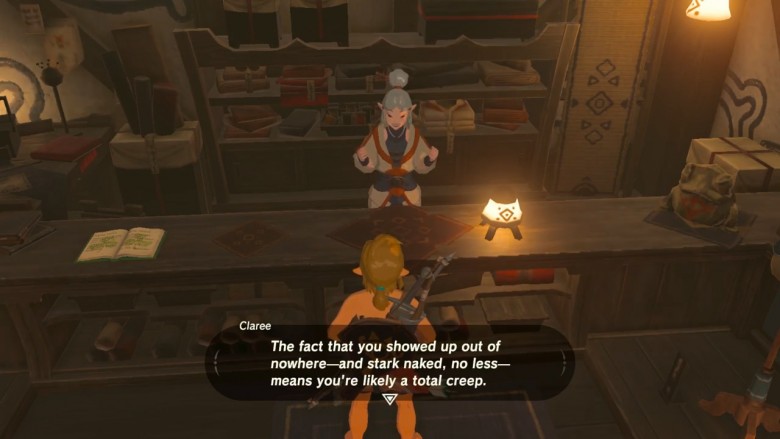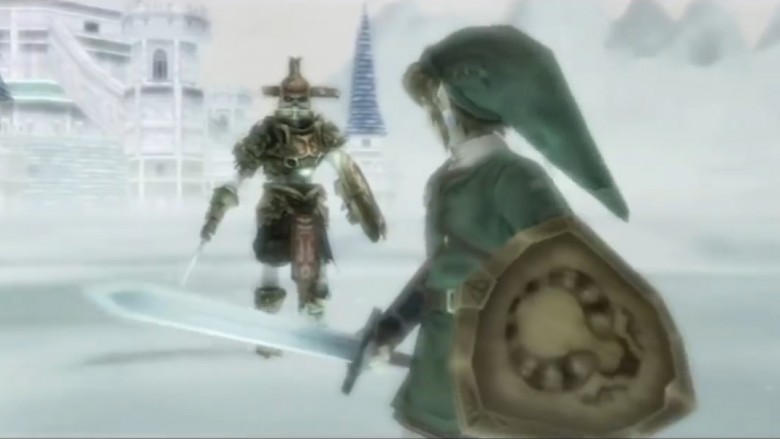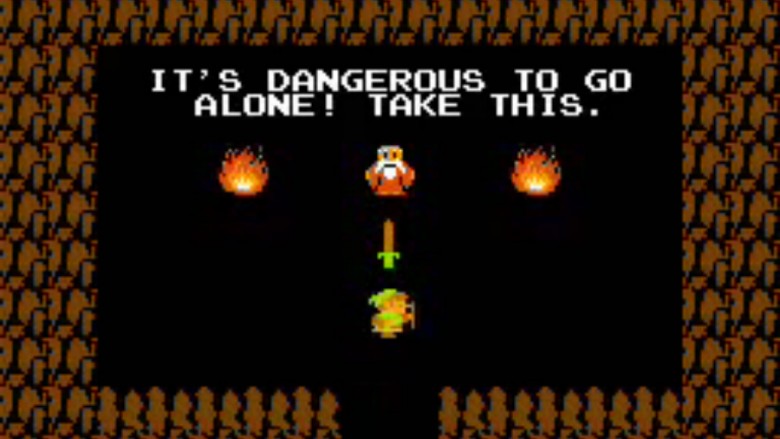The Most Terrible Things Link Has Ever Done
We may receive a commission on purchases made from links.
It's always the quiet ones. Over the course of roughly two dozen The Legend of Zelda games, Link has fought Ganon, rescued various princesses, and kept the mysterious Triforce out of enemy hands. That's all well and good. It's just a shame that the green-clad adventurer causes so much trouble along the way.
From flashing strangers to robbing the dead to beating on poor, defenseless wildlife, Link might ultimately do the right thing, but as he journeys across distant lands, he leaves behind a trail of carnage that would make Hyrule's seven sages weep. They say it's all about the journey, not the destination—and if that's the case, we feel pretty safe calling Link a degenerate, not a champion. He might've saved the world a time or two, but trust us: Link is no hero.
He flashed all of Hyrule
Link's deviant sexual behavior didn't end in the '80s. Link's newest adventure, The Legend of Zelda: Breath of the Wild, is a free-form open-world game with very, very few limits. Want to ignore the main quest and just spend your time causing havoc among Hyrule's ruins? Go right ahead. Want to track down shrines and defeat Ganon while buck naked? You can do that, too.
Okay, so technically, Link always has his underwear on, but he doesn't wear any other clothes if you don't want him to, and that's more than enough to offend Hylians' delicate sensibilities. While some people don't mind seeing Link in the buff—he gets a number of compliments on his physique—others certainly do. Paya, a teenage girl who lives in Kakariko Village, is absolutely traumatized by the sight of Link's flesh, while the Gerudo refuse to let Link inside their city at all, probably because they have little tolerance for perverts. At best, making people uncomfortable like that is selfish. At worst, it's a sex crime, and one that should be punished—ideally by sending Link to the mountains and letting him freeze to death.
He haunted his relatives
Given that he doesn't say much, it's easy to assume that Link is a humble, selfless hero. According to Dark Horse and Nintendo's Hyrule Historia, the official guide to The Legend of Zelda's continuity, that's not entirely true. After the events of The Ocarina of Time and Majora's Mask, the Hero of Time is so furious that he's not remembered for his accomplishments that he sticks around for hundreds of years as a ghost, stewing in his own resentment until a better, stronger, and hopefully more famous Link comes along.
It's not enough for the Hero of Time to just hold a grudge, either. In Twilight Princess, he actually haunts the younger Link (one of the Hero of Time's many descendants), stalking him as a glowing wolf and terrifying the boy with his grotesque, skeletal visage. While that actually ends up working out pretty well for Twilight Princess' Link—in order to preserve his legacy, the Hero's Shade teaches Link advanced sword-fighting techniques—that kind of petty jealousy doesn't jive at all with how most people think of Link, begging a pretty big question: what else is the Hero of Time hiding?
He beat the stuffing out of poultry
When cuccos—Hyrule's answer to chickens—first appeared in The Legend of Zelda: A Link to the Past, they didn't do much but wander around and cluck, leaving players to wonder what exactly they're good for. The answer is, well, pretty much nothing, unless you like whacking farm animals with a sword.
As it turns out, many Zelda fans do like whacking farm animals with a sword, and the poor cuccos have been the targets of Link's aggression ever since. In fact, Hyrule's poultry have been hit so often that they've formed a group known informally as the Cucco Revenge Squad in order to protect themselves. Smack a cucco too many times and it'll summon its friends, who swarm Link from all directions and slowly peck him to death.
This isn't a one-time thing, either. Hittable cuccos—and their revenge-minded friends—have appeared in almost every Zelda game from A Link to the Past all the way through the latest entry, Breath of the Wild. Even spin-offs like the hack-and-slash combat game Hyrule Warriors have gotten in on the chicken-bashing action.
He sexually harassed Zelda
Aside from a few grunts and moans, video game Link is almost entirely silent. On television, that's different. And while it's probably a good thing to have a main character who can, y'know, talk, there's no good explanation for why the producers of The Legend of Zelda animated series turned Link from noble hero into a wise-cracking brat.
If cartoon Link had just been a whiner, it would be bad enough, yet The Legend of Zelda's producers decided to turn the Hero of Hyrule into a budding sexual predator on top of everything else. Look at the very first episode. Before the main plot even begins, Link complains about living in Hyrule and sleeping in a bed, ogles Zelda while she's getting dressed, catcalls her (if you think it's appropriate to yell "Lookin' good, Princess, especially from this angle!" at a woman who has her back turned, we need to have a chat), and tries to kiss Zelda when she isn't expecting it. That all happens in the first six minutes.
It doesn't get better. Over the course of The Legend of Zelda's mercifully brief run, Link spends almost all of his time making passes at Zelda and trying to steal kisses at the most inopportune times. Combine Link's unseemly behavior with his shameless theft from other, better comedians (c'mon, Link, that's Steve Martin's catchphrase), and you end up with one of the most irritating and despicable characters that's ever graced the airwaves.
He robbed graves
Most The Legend of Zelda games revolve around finding treasure. If you need money, cut down tall grass. If you have to scale a seemingly insurmountable obstacle, pop into the nearest dungeon and pick up a fresh weapon—in most cases, your new gear will clear your way. To gather more health, you can find Heart Pieces hidden in trees and all sorts of other places, while life-giving fairies tend to congregate around springs and waterfalls.
In short, in Hyrule, goodies are stashed everywhere, including in the final resting places of Hylians' dearly departed loved ones. In the original The Legend of Zelda's challenging Second Quest, Link uncovers a Heart Piece or a potion by pushing over a gravestone. In A Link to the Past, knocking a gravestone aside and climbing into the tomb below nets Link a cape with invisibility powers.
Link's worst offense, however, occurs in Ocarina of Time, where the young adventurer doesn't even bother to do the grave-robbing himself. When Link visits Kakariko Graveyard, he can fork over 10 rupees to make the local gravekeeper dig a hole wherever Link wants, uncovering anything from a few bucks to an entire Heart Container. Sure, Nintendo tries to make it sound like a fun game by naming the mini-game "Dampé's Heart-Pounding Gravedigging Tour," but c'mon. We know what's really going on here, and it is not okay.
He transformed Hyrule into a post-apocalyptic hellscape
Buckle up, kids, it's time for a history lesson. While The Legend of Zelda games share many tropes—a boy named Link, a princess named Zelda, an all-powerful artifact called the Triforce, and so on—for the most part, they all have separate plots.
That doesn't mean that they aren't connected, however. According to the Hyrule Historia, Zelda games are actually split into different timelines, all of which hinge on The Legend of Zelda: Ocarina of Time. If you follow Ocarina of Time's Link after he changes the future and returns to his childhood, then games like Majora's Mask, Twilight Princess, and the co-op title Four Swords Adventures happen. If you stay in the adult timeline, in which Ganon is defeated and Link disappears after he heads home, then Wind Waker and its spinoffs, Phantom Hourglass and Spirit Tracks, become the new reality.
And there's a third option: Link loses and Ganon takes over. That sets up A Link to the Past, A Link Between Worlds, the NES original, Zelda II: The Adventure of Link, and all three of Link's Game Boy adventures.
Basically, that means that in the continuity that spawns the majority of the The Legend of Zelda games, Link completely and utterly fails, sending Hyrule plummeting into ruin (seriously, the timeline is officially called "The Decline of Hyrule"). There aren't any towns in the first Legend of Zelda game because Ganon destroyed them all, forcing the few Hylians who remain to hide in dark caves. The tree that hides the entrance to The Legend of Zelda's first dungeon is assumed to be the ruins of the Great Deku Tree, which has been dead for centuries. Hyrule crumbles and falls because Link can't get the job done, forcing his descendants to fight their way through the ruins and clean up his world-spanning mess.
He destroyed an entire island and everyone on it
In The Legend of Zelda: Link's Awakening, Link washes up on Koholint Island after his ship is wrecked during a storm. A young girl named Marin nurses him back to health, and when he wakes up, Link begins looking for a way home. Eventually, Link learns that he can escape Koholint by waking up the Wind Fish, a slumbering monster at the heart of the island. But there's a catch: Koholint is the product of the Wind Fish's dream, and waking him will destroy the island and all of its inhabitants.
So, naturally, that's exactly what Link does. Marin and Koholint vanish, and Link wakes up in the middle of the ocean, clinging to a piece of driftwood. The Hyrule Historia is completely unambiguous about this, too. The book says, "Though Link the Hero had once rescued Hyrule, it came to pass that he was also responsible for the annihilation of the dream world," and calls his choice to destroy Koholint a "bitter decision." All that, and Link doesn't even get back to Hyrule. According to the Historia, that particular incarnation of Link sets sail after his adventure on Koholint ends, but "his further whereabouts are unknown," meaning that Link effectively destroyed an island for absolutely no reason.




